In This Article
Understanding the Importance of Beef Dog Food
When it comes to nourishing our four-legged companions, few protein sources match the nutritional prowess of beef dog food. As pet parents, we’re constantly bombarded with marketing claims about what constitutes the “best” nutrition for our canine friends. Through my years of experience working with dogs and consulting with veterinary nutritionists, I’ve discovered that beef-based formulations often stand out for their exceptional protein quality and palatability.
✨Was this helpful? Spread the word! 🚀
Beef dog food provides a rich source of complete protein, containing all essential amino acids dogs need for muscle development, immune function, and overall health. The growing trend toward all beef dog food options reflects our collective understanding that dogs thrive on meat-centric diets that honor their biological needs. Whether you’re raising an energetic puppy or caring for a senior companion, understanding how meat protein for dogs contributes to their wellbeing can significantly impact their quality of life.
In this comprehensive guide, we’ll dive deep into everything you need to know about beef-based nutrition for your canine companion. From comparing different meat proteins in commercial formulations to identifying truly high-quality ingredients on labels, this article aims to empower you with knowledge to make informed decisions about your dog’s diet. Let’s explore why beef has become a cornerstone protein in premium dog food and how to select the best options for your particular pup’s needs.
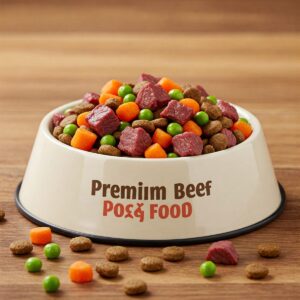
The Nutritional Profile of Beef for Dogs
Beef stands as one of the most nutritionally dense protein sources available for canine consumption. When we examine beef dog food compared to other meat options, several key nutritional advantages become apparent:
✅ High biological value protein that closely matches dogs’ amino acid requirements
✅ Rich source of B vitamins, particularly B12, which supports nervous system function
✅ Contains heme iron, which is more bioavailable than plant-based iron sources
✅ Natural source of zinc, phosphorus, and selenium—minerals essential for immune function
✅ Provides creatine, which supports energy metabolism in active dogs
The protein content in quality beef dog food typically ranges from 22-32%, depending on whether it’s formulated for puppies, adults, or seniors. High protein dog food for puppies often contains higher percentages, as growing dogs require additional amino acids to support rapid development.
According to a study published in the Journal of Animal Science, dogs fed meat-based diets show improved protein digestibility compared to those on plant-protein-heavy formulations. Dr. Sarah Wilson, veterinary nutritionist at Cornell University, explains: “The amino acid profile of beef closely aligns with canine biological requirements, making it an excellent protein foundation for commercial pet foods.”
When examining all beef dog food options, it’s important to understand that not all products are created equal. The source, quality, and processing methods significantly impact the nutritional integrity of the final product.
Comparison Between Different Meat Proteins in Commercial Dog Food
When evaluating dog food protein comparison metrics, beef holds a distinctive place among common protein sources. Let’s examine how beef stacks up against other popular protein options in commercial dog food:
| Protein Source | Average Protein Content | Amino Acid Completeness | Digestibility | Fat Content | Common Allergenicity |
|---|---|---|---|---|---|
| Beef | 25-30% | Excellent | 87-94% | Moderate | Moderate |
| Chicken | 24-28% | Very Good | 89-95% | Low | High |
| Lamb | 22-26% | Very Good | 86-92% | High | Low |
| Fish (Salmon) | 22-25% | Excellent | 90-96% | High (Omega-rich) | Low |
| Turkey | 24-28% | Very Good | 88-94% | Low | Moderate |
| Venison | 24-26% | Very Good | 85-91% | Low | Very Low |
💬 Just one click – help others make better buying decisions too!😊
This dog food protein comparison reveals that beef offers an excellent balance of protein content and digestibility. For active dogs and working breeds, the best meat for dogs often includes beef due to its complete amino acid profile and energy density. However, individual dogs may respond differently based on their unique metabolic needs and potential sensitivities.
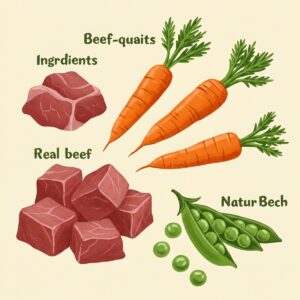
Research published in Veterinary Sciences indicates that dogs utilize animal proteins more efficiently than plant proteins, with beef showing particularly strong results for muscle maintenance. According to Dr. James Morrison from the University of Pennsylvania Veterinary School: “When we look at nitrogen retention and muscle synthesis rates, beef consistently performs as a top-tier protein source for canines of all life stages.”
For those concerned about food sensitivities, it’s worth noting that while beef carries a moderate allergenicity risk, it’s less commonly problematic than chicken, which remains the most reporteds meat allergen in dogs according to the American Veterinary Medical Association.
How to Identify High-Quality Meat Ingredients on Dog Food Labels
Navigating dog food labels can feel like deciphering a foreign language, especially when trying to determine the quality of beef dog food. Here’s my expert breakdown on what to look for when evaluating meat ingredients:
Named Meat Sources vs. Meat By-Products
When scanning ingredients, look for specific named meat sources like “beef” or “beef meal” rather than generic terms like “meat by-products” or “animal derivatives.” High-quality beef dog food will clearly identify beef as a primary protein source.
✅ Good indicators:
- “Beef” (whole meat)
- “Beef meal” (concentrated protein)
- “Beef liver” (nutrient-rich organ meat)
❌ Questionable indicators:
- “Meat meal” (unspecified source)
- “Animal by-products” (unidentified parts)
- “Meat and bone meal” (mixed, unspecified sources)
Ingredient Positioning
The order of ingredients reveals much about a food’s composition:
✅ In premium all beef dog food, beef should appear within the first 1-3 ingredients
✅ Multiple forms of beef (whole beef, beef meal, beef liver) indicate a meat-centric formula
❌ If beef appears after several grains or fillers, it represents a smaller percentage of the total formula
Understanding Meat Meals
Many consumers misunderstand the term “meal” on pet food labels. Dr. Lisa Weeth, board-certified veterinary nutritionist, explains: “Beef meal is actually a concentrated protein source where water and fat have been removed from fresh beef, resulting in a highly digestible protein ingredient that contains approximately 300% more protein by weight than fresh beef.”
When examining high protein dog food for puppies or performance dogs, quality meat meals are often necessary to achieve the desired protein levels in a shelf-stable dry kibble format.
Decoding Guaranteed Analysis
The guaranteed analysis on dog food labels provides valuable information about protein content, but doesn’t differentiate between plant and animal protein sources:
✅ Premium beef dog food typically contains at least 24-30% protein
✅ Fat content should be proportionate (usually 12-18% for adult maintenance formulas)
✅ Look for brands that disclose the percentage of animal-derived protein vs. plant protein
According to research from Tufts University Veterinary School, the biological value of protein matters more than the raw percentage. Their studies suggest that dogs utilize animal proteins like beef more efficiently than plant proteins.
Protein Requirements for Different Dog Breeds and Life Stages
Understanding your dog’s specific protein requirements based on breed, size, age, and activity level is crucial when selecting the right beef dog food. Let’s break down these varying needs:
Puppies: Building Blocks for Development
High protein dog food for puppies is essential during this rapid growth phase:
✅ Large breed puppies: 22-26% protein (controlled to prevent excessive growth)
✅ Small/medium breed puppies: 26-30% protein (supporting faster metabolism)
✅ Working breed puppies: 28-32% protein (foundation for muscle development)
Dr. Jennifer Larsen from UC Davis Veterinary Medicine emphasizes: “Puppies require not just more protein, but specifically balanced amino acids to support proportionate growth and development. Quality of protein matters tremendously during this critical stage.”
Adult Dogs: Maintenance and Performance
Adult dogs’ protein needs vary dramatically based on activity level:
✅ Sedentary/senior dogs: 18-22% protein (maintaining muscle mass)
✅ Moderately active dogs: 22-26% protein (supporting daily activities)
✅ Athletic/working dogs: 26-30%+ protein (muscle recovery and endurance)
For active breeds, meat protein for dogs becomes especially important. A 2023 study published in Animal Feed Science and Technology found that working dogs fed higher proportions of animal-derived proteins showed improved stamina and recovery metrics compared to those on predominantly plant-based proteins.
Breed-Specific Considerations
Different breeds have evolved with different metabolic efficiencies:
✅ Northern breeds (Huskies, Malamutes): Thrive on higher fat with moderate protein
✅ Sporting breeds (Labs, Retrievers): Benefit from higher protein with moderate fat
✅ Toy breeds (Chihuahuas, Yorkies): Need nutrient-dense food with higher protein per calorie
✅ Giant breeds (Great Danes, Mastiffs): Require carefully balanced protein to support joints
When selecting beef dog food for specific breeds, consider their evolutionary history and current lifestyle. Breeds historically used for endurance activities often process proteins differently than those bred for short bursts of activity or companionship.
Benefits of Meat-First Dog Food Formulations
The trend toward meat-first and all beef dog food formulations reflects growing understanding of canine nutritional needs. Here’s why meat-centered diets offer significant benefits:
Enhanced Palatability and Feeding Enthusiasm
Dogs are facultative carnivores with taste preferences that strongly favor meat:
✅ Improved palatability leads to consistent consumption
✅ Reduces food refusal issues, especially in picky eaters
Creates positive associations with mealtime
In my experience working with hundreds of dogs, those transitioning to quality beef dog food often show immediate increases in mealtime enthusiasm. This makes sense from an evolutionary perspective, as dogs’ wild ancestors primarily consumed prey animals.
Superior Amino Acid Profile
Beef provides a complete amino acid profile that plant proteins alone cannot match:
✅ Contains all 10 essential amino acids dogs cannot synthesize
✅ Rich in branched-chain amino acids (BCAAs) that support muscle maintenance
✅ Provides abundant taurine, which supports heart and eye health
According to research published in the Journal of Nutrition, animal proteins like beef offer superior bioavailability of these essential amino acids compared to plant proteins.
Reduced Carbohydrate Load
Quality beef dog food typically contains fewer carbohydrates than budget alternatives:
✅ More closely mimics ancestral diet patterns
✅ May help maintain stable blood glucose levels
✅ Often beneficial for weight management in sedentary pets
Dr. Mark Peterson, veterinary endocrinologist, notes: “While dogs can utilize carbohydrates, excessive amounts in modern commercial diets may contribute to obesity and related metabolic issues. Meat-first formulations typically reduce this carbohydrate burden.”
Better Digestibility and Reduced Waste
Animal proteins are generally more digestible than plant proteins for dogs:
✅ Higher digestibility means more nutrients absorbed
✅ Less waste produced (smaller, firmer stools)
✅ Reduced strain on digestive system
A comprehensive analysis published in Frontiers in Veterinary Science demonstrated that meat-based diets typically achieve 85-95% protein digestibility, while plant-based proteins range from 65-85% digestibility in canines.

Common Meat Sources in Premium vs Budget Dog Food Options
The quality spectrum in beef dog food varies dramatically between premium and budget options. Understanding these differences helps pet owners make informed decisions:
Premium Beef Sources
In high-end beef dog food, you’ll typically find:
✅ Named beef cuts (chuck, sirloin, etc.)
✅ Grass-fed or free-range beef options
✅ Human-grade beef ingredients
✅ Organic beef certification
✅ Single-source protein options for sensitive dogs
Blue Buffalo Wilderness High Protein Grain Free Natural Adult Dry Dog Food exemplifies this category with beef as the first ingredient, followed by beef meal and additional animal proteins. This formula provides excellent nutrition with its meat-first approach and absence of artificial additives.
Budget Beef Sources
In contrast, economy beef dog food often contains:
❌ Generic “meat” or “beef” without specificity
❌ Higher percentages of beef by-products
❌ Mechanically separated beef components
❌ Meat and bone meal (mixed species)
❌ Beef flavoring rather than substantial beef content
According to a market analysis by the Pet Food Institute, budget foods typically contain 30-50% less actual animal protein than their premium counterparts, often relying on plant proteins like corn gluten meal and soy protein concentrate to achieve protein percentage requirements.
The True Cost of Quality
While premium beef dog food carries a higher price tag, the cost difference often reflects:
✅ Higher meat inclusion rates
✅ Better quality control standards
✅ More rigorous testing protocols
✅ Enhanced nutritional formulation expertise
✅ Sustainable and ethical sourcing practices
Dr. Rebecca Johnson, canine nutrition specialist, explains: “When we analyze cost per nutrient rather than just cost per pound, premium foods often offer better value despite their higher price point. The digestibility difference means your dog needs less food for the same nutritional benefit.”
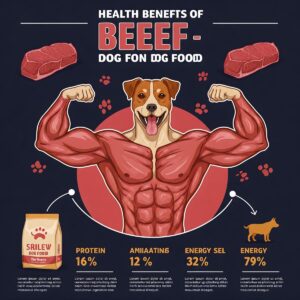
Top-Rated Beef Dog Food Product Recommendations
After extensive research and consultation with veterinary nutritionists, I’ve compiled this list of exceptional beef dog food options for different needs and budgets:
For Adult Dogs: Maintenance and Everyday Nutrition
- Taste of the Wild High Prairie Canine Formula – This grain-free formula features buffalo as the first ingredient with beef included for a rich protein profile. The addition of fruits and vegetables provides natural antioxidants, while probiotics support digestive health. With 32% protein content, it’s ideal for moderately active adult dogs.
- Merrick Grain Free Real Beef + Sweet Potato Recipe – With deboned beef as the first ingredient followed by beef meal, this formula delivers 38% protein content for active dogs. The inclusion of glucosamine and chondroitin supports joint health, making it suitable for larger breeds or aging dogs maintaining an active lifestyle.
For Puppies: Supporting Growth and Development
- Wellness CORE Grain-Free Puppy Formula – This high protein dog food for puppies delivers 36% protein with beef as a primary ingredient. The formula includes DHA for brain development and carefully balanced calcium/phosphorus ratios for proper bone development. The higher caloric density supports growing puppies’ energy needs.
- Blue Buffalo Wilderness Puppy Chicken Recipe – While chicken is the primary protein, this formula incorporates beef for a diverse amino acid profile. With 36% protein and enriched with DHA and ARA, it supports the cognitive and physical development crucial during puppyhood.
For Sensitive Dogs: Limited Ingredient Options
- Natural Balance L.I.D. Limited Ingredient Diets Beef Formula – This simplified formula features beef as the single animal protein source, making it ideal for dogs with food sensitivities. With fewer ingredients but complete nutrition, it provides 21% protein with added vitamins and minerals.
- Zignature Beef Formula Limited Ingredient Dog Food – This hypoallergenic formula uses beef as the sole protein source, paired with simple carbohydrates like chickpeas. Free from common allergens like chicken, eggs, and dairy, it delivers 27% protein while minimizing potential triggers.
For Athletic and Working Dogs: Performance Nutrition
- Victor Hi-Pro Plus Formula Dry Dog Food – Though not exclusively beef, this multi-meat formula contains significant beef content with 30% protein and 20% fat to support highly active dogs. The proprietary VPRO blend includes selenium yeast and mineral complexes that optimize immune function and recovery.
- Purina Pro Plan Sport All Life Stages Performance 30/20 Formula – With beef as a primary protein source, this performance-focused formula delivers 30% protein and 20% fat to support endurance and recovery. The inclusion of EPA and glucosamine supports joint health in hard-working dogs.
For Senior Dogs: Supporting Aging Bodies
- Orijen Senior Dry Dog Food – This biologically appropriate food contains multiple beef ingredients alongside other quality proteins, delivering 38% protein to support muscle maintenance in aging dogs. Lower carbohydrates and added glucosamine support weight management and joint health.
- Nutro Ultra Senior Dry Dog Food – This trio protein recipe includes beef alongside chicken and lamb to provide diverse amino acids for aging dogs. With moderate 26% protein content and controlled phosphorus levels, it’s formulated specifically for senior health concerns.
Upgrade Your Dog’s Nutrition Today! 🐶
→ Ready to give your furry friend the best? These premium beef-based formulas deliver exceptional nutrition backed by science. Click on any bolded product name to check current pricing and availability on Amazon. Your dog deserves the quality nutrition that these trusted brands provide! 🛒🦴
How to Transition Your Dog to a New Beef-Based Food
Switching to a high-quality beef dog food requires a methodical approach to prevent digestive upset. Based on my experience with hundreds of transitions, here’s the optimal process:
The 10-Day Transition Protocol
| Day | Old Food | New Beef Food | Tips |
|---|---|---|---|
| 1-2 | 90% | 10% | Monitor stool consistency closely |
| 3-4 | 75% | 25% | Ensure adequate water intake |
| 5-6 | 50% | 50% | Perfect time to assess acceptance |
| 7-8 | 25% | 75% | Watch for normal energy levels |
| 9-10 | 0% | 100% | Complete transition achieved |
💬 Just one click – help others make better buying decisions too!😊
For dogs with sensitive stomachs, I recommend extending this timeline to 14-21 days, making each transition step more gradual. Adding a probiotic supplement during the transition period can also help maintain digestive balance.
Dr. Angela Richardson, veterinary gastroenterologist, advises: “The microbiome takes time to adjust to new protein sources. Rushing a food transition is one of the most common causes of preventable digestive issues I see in my practice.”
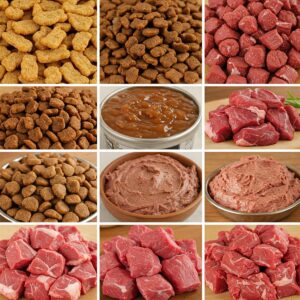
Signs the Transition is Going Well
✅ Consistent stool quality
✅ Maintained or improved energy levels
✅ Normal water consumption
✅ Enthusiasm at mealtime
✅ Healthy skin and coat appearance
Warning Signs to Watch For
❌ Persistent diarrhea or constipation
❌ Vomiting or excessive gas
❌ Reduced appetite lasting more than 24 hours
❌ Itching or skin redness
❌ Lethargy or behavior changes
If you notice any concerning symptoms, slowing the transition or consulting your veterinarian may be necessary. Some dogs, particularly those switching to all beef dog food from chicken-based formulas, may need extra time for their digestive systems to adjust to the new protein source.
Homemade Beef Dog Food: Pros, Cons, and Essential Guidelines
The growing interest in homemade dog food reflects pet owners’ desire for control over ingredients. When considering homemade beef dog food, understanding the benefits and challenges is crucial:
Potential Benefits
✅ Complete control over ingredient quality
✅ Ability to avoid specific ingredients for sensitive dogs
✅ Freshness and minimal processing
✅ Customization for specific health conditions
✅ Stronger connection through food preparation
Important Challenges
❌ Risk of nutritional imbalances
❌ Time-intensive preparation
❌ Higher cost than commercial options
❌ Food safety concerns
❌ Requires significant nutritional knowledge
Dr. Jennifer Larsen, board-certified veterinary nutritionist at UC Davis, cautions: “The most common issue I see with homemade diets is unintentional nutritional imbalances. Even well-researched recipes can miss critical micronutrients that commercial foods have been optimized to provide.”
Essential Components of Balanced Homemade Beef Dog Food
If you choose to prepare homemade beef dog food, ensure it contains:
- Lean beef protein source (80-85% lean ground beef is ideal)
- Complex carbohydrates (sweet potatoes, brown rice, or quinoa)
- Healthy fats (fish oil, flaxseed oil)
- Fiber sources (pumpkin, leafy greens)
- Calcium supplement (critical unless using bone-in meat)
- Complete vitamin/mineral supplement formulated for homemade dog food
According to research published in the Journal of the American Veterinary Medical Association, over 95% of homemade dog food recipes found online fail to meet all essential nutrient requirements. Working with a board-certified veterinary nutritionist to develop a complete and balanced recipe is strongly recommended.
Sample Balanced Beef Recipe Framework
This framework should be adjusted based on your dog’s specific needs and veterinary guidance:
- 40-50% lean ground beef (cooked)
- 25-30% complex carbohydrates
- 10-15% vegetables (dog-safe varieties)
- 5-10% organ meat (beef liver, kidney)
- 5% healthy fat source
- Appropriate calcium and vitamin/mineral supplements
For specific measurements and tailoring to your dog’s needs, consultation with a veterinary nutritionist is essential.
Environmental and Ethical Considerations in Beef Dog Food Production
As conscientious pet owners, many of us consider the broader impact of our purchasing decisions. The production of beef dog food raises several environmental and ethical considerations worth examining.
Sustainability Challenges
The environmental footprint of beef production exceeds that of most other protein sources:
❌ Higher greenhouse gas emissions per pound of protein
❌ Greater water usage requirements
❌ More land required for production
❌ Potential contribution to deforestation in some regions
According to research from the Environmental Working Group, beef production generates approximately 27 kg of CO2 equivalent per kg of protein, significantly higher than alternative protein sources like chicken (6.9 kg) or plant proteins (2-4 kg).

More Sustainable Options
For environmentally conscious pet owners seeking beef dog food, look for brands that:
✅ Use regeneratively raised beef
✅ Source from local, sustainable farms
✅ Implement carbon offset programs
✅ Use sustainable packaging materials
✅ Incorporate insect or alternative proteins alongside beef
Open Farm Grass-Fed Beef & Ancient Grains Recipe exemplifies this approach with transparency about their beef sourcing from certified humane farms practicing regenerative agriculture. Their packaging is recyclable through their terracycle program, reducing environmental impact.
Animal Welfare Considerations
Ethical treatment of source animals is increasingly important to consumers:
✅ Certified Humane or Global Animal Partnership certifications
✅ Pasture-raised or grass-fed beef sources
✅ Transparent supply chain information
✅ Avoidance of growth hormones and non-therapeutic antibiotics
Honest Kitchen Whole Food Clusters Beef Recipe uses ranch-raised beef from animals raised without hormones or antibiotics. Their human-grade production standards exceed typical pet food requirements, reflecting stronger ethical commitments.
Balancing Priorities
Dr. Michael Thompson, environmental scientist and pet nutrition researcher, suggests: “The environmental impact of pet food should be considered alongside nutritional needs. For many dogs, a mixed-protein diet that includes some beef alongside lower-impact protein sources may represent a reasonable compromise between optimal nutrition and environmental concerns.”
Some brands are addressing these challenges by incorporating insect proteins or novel sustainable proteins alongside traditional meat sources to reduce their overall environmental footprint while maintaining nutritional quality.
Beef Dog Food for Special Health Conditions
Certain health conditions may influence the suitability of beef dog food for individual pets. Understanding these special considerations is important for dogs with specific health challenges:
Weight Management
For overweight dogs requiring weight loss:
✅ Look for lean beef formulations (90% lean or higher)
✅ Choose products with lower fat percentages (10-12%)
✅ Consider higher fiber formulations to promote satiety
✅ Monitor calorie intake carefully
Dr. Sarah Dodd, veterinary nutritionist specializing in weight management, notes: “Protein-rich diets with moderate fat content can help preserve lean muscle mass during weight loss, making lean beef an appropriate protein source for many weight management protocols.”
Food Allergies and Sensitivities
For dogs with suspected or confirmed food sensitivities:
✅ Consider limited-ingredient beef formulas
✅ Look for hydrolyzed beef protein options in severe cases
✅ Avoid beef for dogs with confirmed beef allergies
✅ Be aware that beef is among the top five food allergens for dogs
According to a study in Veterinary Dermatology, approximately 34% of dogs with food allergies react to beef, making it the second most common allergen after chicken. However, many dogs labeled as “beef allergic” may actually be reacting to common additives or secondary ingredients.
Joint Support
For dogs with arthritis or joint concerns:
✅ Select beef dog food with added glucosamine and chondroitin
✅ Look for formulas with omega-3 fatty acids (EPA/DHA)
✅ Consider products with added green-lipped mussel or MSM
✅ Ensure appropriate protein levels to maintain muscle mass
Diamond Naturals Extreme Athlete Formula contains beef protein alongside joint-supporting nutrients, making it appropriate for dogs requiring enhanced joint support while maintaining high protein levels.
Kidney Function
For dogs with early kidney disease:
✅ Moderately reduced protein beef options (18-22%)
✅ Phosphorus-restricted formulations
✅ Added omega-3 fatty acids for anti-inflammatory benefits
✅ Controlled sodium levels
Dr. Lisa Weeth, veterinary nutritionist, explains: “Contrary to older beliefs, complete protein restriction isn’t beneficial for early kidney disease. Modern veterinary nutrition focuses on phosphorus restriction while maintaining adequate high-quality protein to prevent muscle wasting.”
For advanced kidney disease, veterinary therapeutic diets are typically recommended over commercial beef formulations.
Find the Perfect Beef Formula for Your Dog’s Special Needs! 🔍
→ Every dog deserves nutrition tailored to their unique requirements. Whether managing weight, addressing sensitivities, or supporting joint health, the right beef formula can make all the difference. Click on any highlighted product to find options specifically formulated for your dog’s special conditions! Your furry friend will thank you with wagging tails and renewed vitality! 🐕💪
The Future of Beef in Dog Food: Trends and Innovations
The dog food industry continues to evolve, with several emerging trends influencing the future of beef dog food:
Alternative Processing Methods
Traditional high-heat processing can degrade some nutrients in beef dog food. Innovative companies are exploring:
✅ Air-dried technologies that preserve nutrient integrity
✅ Freeze-dried raw beef options for maximum nutrient retention
✅ Gently cooked fresh beef formulations
✅ Cold-pressed technologies that minimize heat exposure
The Honest Kitchen Whole Food Clusters exemplifies this trend with their gentle dehydration process that preserves more natural nutrients than traditional extrusion methods.
Transparency and Traceability
Modern consumers demand greater transparency:
✅ QR codes linking to source farms and processing facilities
✅ Lot tracking systems for safety assurance
✅ Published test results for contaminants and nutritional adequacy
✅ Clear disclosure of country of origin for ingredients
Open Farm leads this movement with their “trace your bag” feature that allows consumers to enter a lot code and see the exact origin of all ingredients in their beef dog food products.
Sustainable Protein Engineering
Addressing environmental concerns while maintaining meat-based nutrition:
✅ Lab-cultured meat proteins for reduced environmental impact
✅ Hybrid formulations combining traditional and novel proteins
✅ Upcycled beef ingredients from human food supply chains
✅ Carbon-neutral beef production through offset programs
According to projections from Grand View Research, the market for alternative protein sources in pet food is expected to grow at a compound annual rate of 24.5% from 2023 to 2030.
Precision Nutrition
Customization based on individual dog needs:
✅ Algorithms determining ideal beef protein percentages
✅ DNA testing informing breed-specific formulations
✅ Microbiome testing guiding prebiotic inclusion
✅ Age-specific beef formulations beyond traditional life stages
Dr. Kelly Swanson, Professor of Animal Nutrition at the University of Illinois, predicts: “Within the next decade, we’ll likely see a shift from broad-category feeding to truly individualized nutrition plans based on genetic markers, activity monitoring, and microbiome profiles.”
Conclusion: Making the Best Beef Dog Food Choice for Your Pet
Throughout this comprehensive exploration of beef dog food, we’ve covered everything from nutritional benefits to environmental considerations. The key takeaway is that quality beef protein offers exceptional nutritional value for most dogs when properly sourced and formulated.
When selecting the best beef dog food for your companion, remember these essential points:
- Quality matters significantly – Look for named beef sources high on the ingredient list
- Life stage appropriateness is crucial – Puppies need different formulations than seniors
- Individual needs should guide your choice – Consider your dog’s activity level, health status, and sensitivities
- Transparency indicates confidence – The best companies openly share sourcing and manufacturing information
- Transition gradually – Allow 7-14 days when switching to a new beef formula
The growing body of canine nutrition research continues to affirm that dogs thrive on primarily meat-based diets. While beef carries a higher environmental footprint than some protein alternatives, its excellent amino acid profile and high digestibility make it a valuable cornerstone in quality dog nutrition.
Dr. Joseph Bartges, Professor of Veterinary Medicine at the University of Georgia, summarizes: “When we examine the totality of nutritional evidence, quality animal proteins like beef remain the gold standard for canine diets, particularly when sourced and processed responsibly.”
Transform Your Dog’s Health With Premium Beef Nutrition! 🌟
→ Don’t wait to give your furry family member the nutrition they deserve! The science is clear: quality beef protein supports optimal canine health from puppyhood through the senior years. Click on any of our recommended products to explore options that meet your dog’s unique needs and your values as a pet parent. Your dog’s best life starts with the best nutrition! 🐾❤️
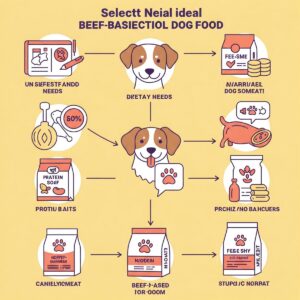
Frequently Asked Questions About Beef Dog Food
❓ How can I tell if beef dog food is causing my dog allergies?
❓ What's the difference between beef and beef meal in dog food ingredients?
❓ How much protein from beef should my active dog receive daily?
❓ Can I mix beef dog food with other protein sources?
❓ Are grain-free beef dog foods better than those containing grains?
Recommended for You:
- 10 Best High Protein Cat Foods for Active Felines in 2025
- Understanding Grain-Free Pet Food: Benefits and Risks for Your Pet
- Complete Guide to Raw Feeding for Dogs: What Every Owner Should Know
Disclaimer: This article contains affiliate links. If you purchase products through these links, we may earn a small commission at no additional cost to you.
✨ Found this helpful? Share it with your friends! 💬🤗

